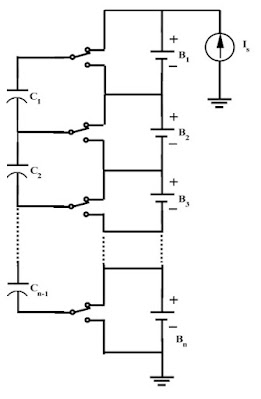https://sailtortuguita.blogspot.com/2023/11/the-balancing-act.html
It's fairly easy to read the battery voltage. It is your system voltage. It can be measured just about anywhere wires run for your 12 (or 24) volt system.

The battery bank on the right is a typical 12 volt Lithium parallel cell arrangement. Each cell contributes 3.2 volts for a total system voltage of 12.8 volts.
This is assuming that all the cells stay at the exact same charge state ie: voltage.
If the charger is set to shut off at 12.8 volts (full charge) and one cell is unbalanced at .2 volts below the others, then the 3 good cells would reach 3.25 volts each and the low cell would be 3.05. That's will put the good cells further into the Knee.However, if an unbalanced cell is .2 volts above the others, then that cell would be at 3.35 volts when the bank is fully charged to 12.8 volts while the others have only reached 3.15 volts.
 | |
| Shunting Transistors for Balancing |
So not only must a BMS be able to monitor the voltage of each cell and shut off charging when any cell exceeds a certain voltage but it must be able to take some voltage from a high cell and put it into the others. This balancing can be either Passive or Active.
Passive balancing is accomplished with transistor controlled shunts which dissipate higher voltage cells into resistors.
In an Active system the BMS switches transistors which redistribute energy in the out of range cell into a capacitor which then is switched into one of the lower voltage cells.
There are 2 types of BMS's. Distributed and Centralized.
 |
| Emus Distributed BMS |
Distributed
BMS's have their sensors mounted out on the cells in the bank and a
network connects the sensors to the BMS 'the brain'. The Distributed cell sensors will sense both voltage and temperature
I thought a Distributed system was silly since the distance between the cells and BMS were so short it didn't seem justified for all the complexity involved.
I started out thinking the Chargery BMS was a good way to go. It was a low priced centralized system that included a display and charger.
I bought one and still have it sitting on the boat because I decided not to use it due to it's overly complex setup options. It also appears to have passive balancing. It would be easy to drain your system with a minor settings mistake and having the passive balancer shunt your cells down to zero.
I ended up choosing the REC Active BMS for our installation. It is a very robust, weatherproof, BMS geared toward marine installations vs. Electric Cars. It is fully CANBus compatible and plays friendly with Victron hardware and displays. The biggest downside is terrible customer support. I will have more on the REC in future posts.


